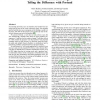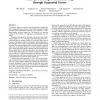96 search results - page 2 / 20 » Detecting Data Races in Sequential Programs with DIOTA |
ASPLOS
2012
ACM
12 years 7 days ago
2012
ACM
Even though most data races are harmless, the harmful ones are at the heart of some of the worst concurrency bugs. Alas, spotting just the harmful data races in programs is like ï...
PLDI
2012
ACM
11 years 7 months ago
2012
ACM
Existing dynamic race detectors suffer from at least one of the following three limitations: (i) space overhead per memory location grows linearly with the number of parallel thre...
POPL
2012
ACM
12 years 2 days ago
2012
ACM
Data races are among the most reliable indicators of programming errors in concurrent software. For at least two decades, Lamport’s happens-before (HB) relation has served as th...
ASPLOS
2011
ACM
12 years 8 months ago
2011
ACM
Concurrency bugs are caused by non-deterministic interleavings between shared memory accesses. Their effects propagate through data and control dependences until they cause softwa...
ISCA
2009
IEEE
13 years 11 months ago
2009
IEEE
Detecting data races in parallel programs is important for both software development and production-run diagnosis. Recently, there have been several proposals for hardware-assiste...


